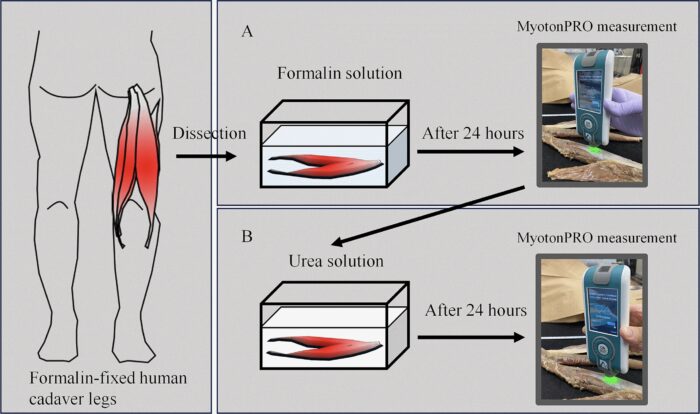Publications

Assessing site-specificity of the biomechanical properties of hamstring aponeuroses using MyotonPRO: A cadaveric study
Authors: Xiyao Shan, Shun Otsuka, Tomohito Okubo, Takao Takeuchi, Kaori Fukushige, Munekazu Naito
Affiliations:
Department of Anatomy, School of Medicine, Aichi Medical University, Nagakute, Aichi, Japan
Journal: Clinical Biomechanics - April 2024, Volume 114, Article no. 106230 (DOI: 10.1016/j.clinbiomech.2024.106230)
-
Field & Applications:
- Reliability
Background: Hamstring muscles are the most frequently reported sites of muscle strain injuries, especially near the bi-articular muscles’ myotendinous junction, where aponeurosis provides a connective tissue network linking muscle fibers to the tendon. This study aimed to investigate the reliability and site-specific differences of hamstring aponeuroses under different conditions (formalin and urea) using MyotonPRO.
Methods: Eight hamstring muscle groups were dissected from four human cadavers (two males and two females) aged 83–93 years. Measurements of the mechanical properties of the aponeuroses from the superficial and deep regions of biceps femoris long head, semitendinosus, and semimembranosus (after formalin solution immersion) were done using MyotonPRO (intra-rater reliability was examined within a 24-h interval), following which the hamstring aponeuroses were measured using a similar procedure after urea solution immersion.
Findings: Test-retest (intra-rater) results revealed that the MyotonPRO measurement of tone, stiffness, relaxation, and creep of cadaveric aponeuroses presented good to excellent reliability (ICC: 0.86 to 0.98). There were no significant differences in tone, stiffness, elasticity, relaxation, and creep among the six sites of hamstring aponeuroses under both formalin and urea conditions. Significant differences between formalin and urea conditions were found in the tone, stiffness, relaxation, and creep of hamstring aponeuroses (P < 0.05).
Interpretation: These results suggested that the biomechanical properties of hamstring aponeuroses showed homogeneity between the sites using MyotonPRO. Urea solution could potentially neutralize the effect of formalin on the biomechanical properties of cadaveric muscle-aponeurosis-tendon units. The present findings might influence the design of subsequent cadaveric studies on hamstring muscle strains.

Figure 1. The protocol of formalin (A) and urea (B) immersion solution on the dissected hamstrings, and the MyotonPRO measurement technique on hamstring aponeuroses.
Keywords: reliability, hamstring muscles, aponeuroses, mechanical testing, myotendinous junction
In summary, we examined the biomechanical properties of the hamstring aponeuroses using MyotonPRO and the results showed inter- and intra-muscular homogeneity in ST, SM, and BF muscles, which appeared to be independent of the fixation conditions of formalin and urea. Other mechanical tests might be beneficial to verify the distribution characteristics of hamstring aponeuroses. Urea solution can potentially neutralize the effect of formalin on the mechanical properties of cadaveric muscle-aponeurosis-tendon units.


